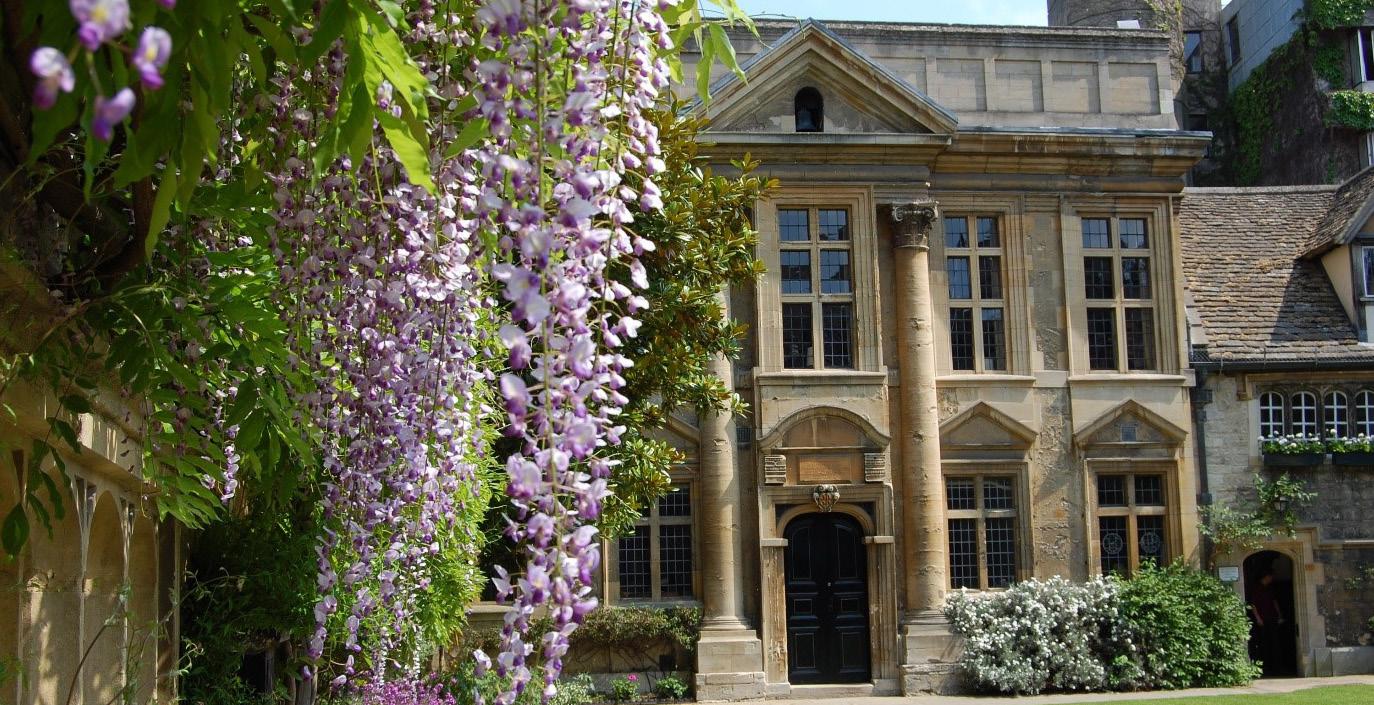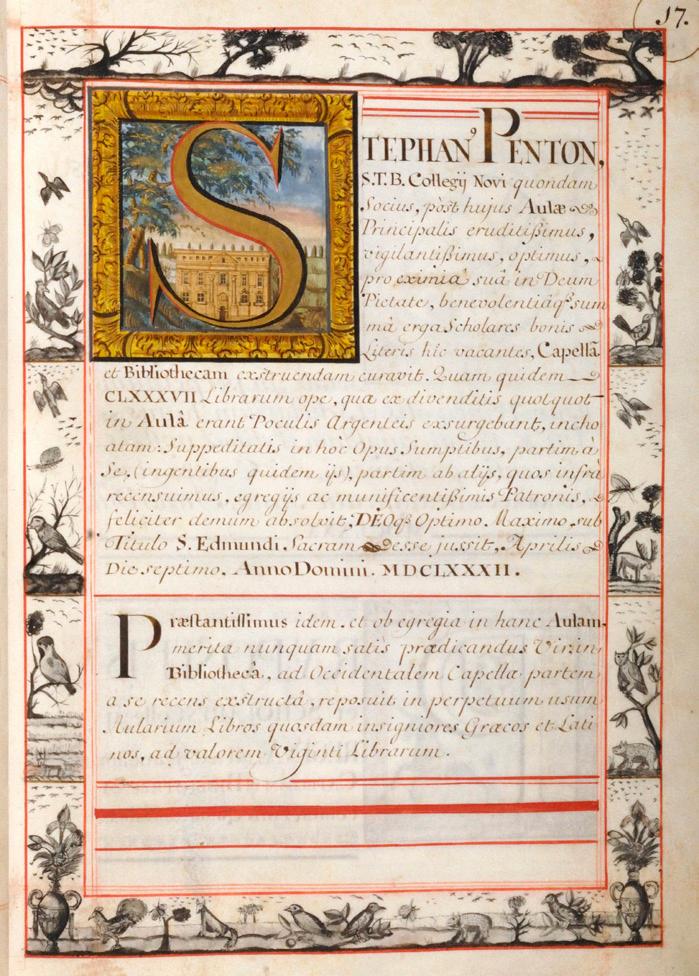
6 minute read
340 years of the Chapel and Old Library
Sunday 19 April marked the 340th anniversary of the laying of the stones of the Hall’s Chapel and Old Library. They were built in 1680 and are a central part of the College life today, providing chapel services, musical performances, reflection and special exhibition spaces. On Monday the 19th of April 1680, 340 years ago, the Oxford antiquarian and historian Anthony Wood made a note in his diary: “19 Apr., Munday, [the] 1[st] stone of Edmund hall chapel and library was layd.” Wood took a keen interest in all the goings on of the University, and at Teddy Hall he had a close confidant and correspondent in Andrew Allam (mat.1670), a scholar who was subsequently Vice-Principal from 16821685. At this time none of the half dozen Oxford Halls that had survived the Middle Ages had both a chapel and a library and only two had either, both of recent vintage. St Mary Hall (now incorporated into Oriel) had a chapel built above its dining hall in 1642 and Magdalen Hall (now part of Hertford) gained a library in 1657 to house 600 books selected by its Principal Henry Wilkinson. So the project to provide Teddy Hall with both was an ambitious undertaking by the Principal Stephen Penton (Principal 1676-1684). Indeed, in the only surviving portrait of Penton in the 1747 University Almanac which featured the Hall and the most notable Aularians, he is pictured holding the plans.
Penton was building on the work of his predecessor, Thomas Tullie (Principal of Teddy Hall from 1658-76). It was Tullie who had instituted the practice that upper commoners (undergraduates of higher social status) should donate silver
St Edmund Hall’s Chapel (ground floor) and Old LIbrary (first floor)
or a book to the value of £5 to the Hall.
The Oxford Almanac for the year 1747, at bottom left: Penton

The donations of books were the foundation of the Library and they were circulating among students before there was a physical library building. A lending list survives in a manuscript now in the British Library with details of loans from 1666-1674. It was the silver though that served Penton’s immediate purposes.
Thirty-nine pieces were sold for £187 in March 1679 to raise funds for the building work. The names of the donors and the inscriptions on the plates that were sold are recorded in an inventory drawn up by Andrew Allam which is preserved among Anthony Wood’s papers in the Bodleian. Many of the items were inscribed ‘In usum Aulæ Sancti Edmundi’ (‘for the use of Saint Edmund Hall’) a sentiment taken rather literally by Penton.
However, although the sale realised the equivalent of tens of thousands of pounds today, it was not enough to fund construction. As so often in its history, the Hall had to turn to its Old Members and its friends for help.
In June of 1680, White Kennett (mat. 1678), at the time an undergraduate but who would go on to be one of the most distinguished Aularians, performed a poem in the Dining Hall appealing for support,
“Thus goes it & pittie ‘twere indeed if once begun it should not once
precede…
Let now your hearts a nobel zeal inspire: So great a work does great cost require…”
More than a hundred donors gave towards the building, raising over £500. Their names and contributions are recorded in the sumptuously illustrated Benefactions Book that Penton commissioned.
Penton’s own entry in the St Edmund Hall Benefaction Book

Penton himself gave generously and was also able to secure the land that the chapel is built on from New College for a nominal rent of 1 shilling a year, helped almost certainly by the fact he had been a Fellow of the College before he became Principal of the Hall (unusually, most Principals came from Queens which had the right of appointment to the post).
As might be expected most of the donors were Aularians or their parents. Their gifts ranged in value from £40, given by Sir Jemett Raymond (mat. 1681) the son of a Lord Mayor of London, to a pound or less, but I think my favourite is the example of Hall spirit shown by Francis Loder (mat. 1670) who not only donated five guineas but also ‘out of his zeal for the public welfare of the Hall… also collected moneys elsewhere for the promotion of the building of the Chapel.’
Many other contributions were received from the heads of houses of other colleges and Halls and from Fellows across the University, notably from our neighbours at Queens, New College and Magdalen.
At first the construction work was swift. On 19 November 1680 Allam wrote to Wood that ‘we shall cover our Library next week.’ Records in the Vice-Chancellor’s accounts note the purchase of stone to the value of £10 by the Hall in 1680-81 for the building work. The design may be by Bartholomew Paisley, the mason who supervised the work. It was many respects a rather modish plan, the first college chapel in Oxford to be built entirely in a classical Palladian style and the Library was first to have shelves against the wall and a gallery.
By April 1682 the chapel was ready for consecration. Allam records that the service was done ‘very privately’ by John Fell, the Bishop of Oxford between ‘half an hour after eight and ten in the morning.” The order of service still survives, a mixture of Latin and English prayers and readings blessing the chapel and dedicating it to St. Edmund.
Proceedings seem to have dragged after this, however. Indeed, the construction outlasted both Penton, who had to retire due to ill health in 1684, and Allam, who died in 1685.
The staircase up to the Library was not put in place until 1685 (this was replaced in the early 20th century by Principal Emden, he describes the original as ‘tortuous and narrow in his history of the Library). Records in the Principal’s Ledger Book record payments made to the joiner Arthur Frogley throughout that year for work on the Library fittings. Frogley also donated a book to the collection, A genealogical history of the kings of Portugal, which is still on the shelves of the Old Library.
The very last decoration in the chapel was finished around 1690, Robert Partridge (mat. 1685) and Henry Worsley (mat.1690) both gave donations that year towards the cedar wainscoting.
Of course, the story of our Chapel and the Old Library does not end in 1690. Both have enriched the lives of succeeding generations of Aularians and been enriched by them. The Chapel has gained its Morris and Burne-Jones stained glass window, the striking Ceri Richards altarpiece and more sombrely the memorial to those who fell in the World Wars. The Old Library has seen many changes, the ending of the chaining of books in the 1760s, the reorganisation and extension it underwent in the 1920s and it’s recent refurbishment.
And that story goes on now, even though the Hall is currently closed. The College is the people who make it up, who do and have lived, studied and worked here as much as its buildings.










